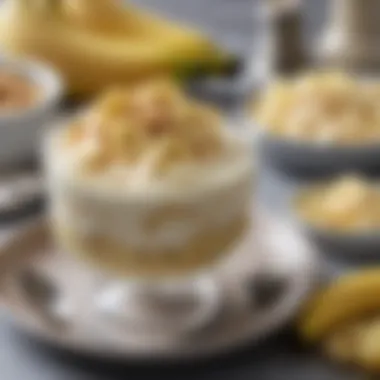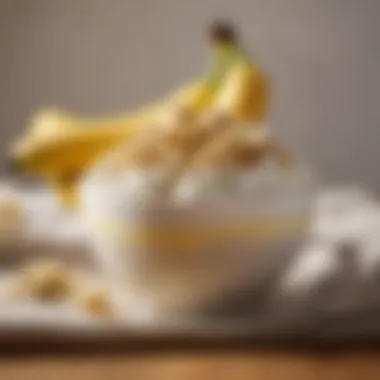Gluten-Free Banana Pudding: A Magnolia Classic


Intro
Banana pudding is more than just a sweet dessert; it is a tradition that connects generations. Originating in the United States, this layered delight has found a special place in the hearts of many. Magnolia Bakery, a staple in New York, has popularized its own version of banana pudding, making it an iconic treat. However, as dietary preferences evolve, the call for gluten-free options has grown stronger.
In this article, we will explore a gluten-free rendition of the famous Magnolia Bakery banana pudding. By going gluten-free, we open the doors for those with dietary restrictions to enjoy this delicious dessert without compromising on taste or texture. We will dissect the classic recipe, offer gluten-free ingredient alternatives, and provide guidance on how to recreate this beloved treat in your kitchen.
Moreover, we will delve into the broader landscape of gluten-free baking, illuminating common challenges and offering practical solutions. By the conclusion, readers will not only know how to make a gluten-free banana pudding but will also appreciate the significance of this adaptation in today’s culinary culture.
Recipe Overview
Recipe Name
Gluten-Free Banana Pudding
Brief Description of the Dish
This gluten-free banana pudding pays homage to Magnolia Bakery's treasured recipe, creating layers of creamy vanilla pudding, fresh bananas, and gluten-free wafers. This delight is a harmonious balance of flavors and textures, making it a memorable dessert experience.
Ingredients List
Main Ingredients
- Ripe bananas
- Gluten-free vanilla wafers
- Heavy cream
- Whole milk
- Sugar
- Cornstarch
- Vanilla extract
- Salt
Optional Ingredients
- Whipped cream (for topping)
- Chocolate shavings or dusting of cocoa powder (for garnish)
- Nuts, like pecans or walnuts (for added crunch)
This list provides the core elements needed for crafting a delectable gluten-free banana pudding. Each ingredient plays a vital role in recreating the signature taste that has attracted dessert lovers for decades.
By carefully selecting gluten-free alternatives, we can maintain the essence of this classic while ensuring that everyone can partake in its enjoyment.
Preface to Gluten-Free Banana Pudding
The topic of gluten-free banana pudding is not just a contemporary culinary trend. It reflects a growing awareness of dietary restrictions and the desire for inclusivity in the world of dessert. Traditional banana pudding, especially as perfected by Magnolia Bakery, has long been celebrated for its layers of flavor and texture. However, for those who are gluten sensitive or suffer from celiac disease, enjoying this dessert can be problematic. This article seeks to elucidate how the classic banana pudding can be adapted into a gluten-free variant, offering an enjoyable experience without compromising taste.
By exploring gluten-free methods, bakers can unlock new possibilities in their culinary repertoire. This adaptation allows for creativity in ingredient selection and preparation methods. Additionally, it highlights the importance of catering to diverse dietary needs while maintaining the essence of beloved recipes.
Moreover, understanding gluten-free banana pudding connects readers to the broader conversation of gluten-free cooking. This includes the ingredients that work well as substitutes and the techniques necessary to achieve the same creamy consistency of the traditional pudding. As we delve into the history of banana pudding and the modern gluten-free movement, we will discover not just recipes but also the cultural significance behind these beloved desserts.
The Magnolia Bakery Influence
The presence of Magnolia Bakery in the culinary landscape cannot be overstated. This establishment has become synonymous with banana pudding, an iconic dessert that has been embraced by many. The influence of this bakery extends beyond mere flavor; it is about creating an experience that resonates with nostalgia and comfort. The Magnolia style of banana pudding is not just food; it is a memory that many associate with gatherings and celebrations, making it a cultural staple.
Understanding the significance of Magnolia Bakery in crafting the best banana pudding provides insights into why so many people are excited about making gluten-free versions. As more individuals seek gluten-free options, the techniques and ingredients employed by Magnolia can serve as a foundation for these adaptations.
When discussing the key elements of Magnolia's banana pudding, the focus primarily remains on the assembly of rich flavors and smooth textures. Traditional recipes create the balance rather effortlessly, and this balance must be maintained even when gluten-free substitutes are introduced. It challenges the maker to innovate while preserving that much-loved essence of the original.
Unquestionably, the Magnolia Bakery influence leads the way for gluten-free adaptations. It provides a starting point for home bakers eager to replicate a beloved dish while respecting dietary restrictions. With this in mind, we can delve deeper into the origins and signature elements that make this dessert so special.
Origins of the Magnolia Bakery Recipe


The origins of Magnolia Bakery's banana pudding can be traced back to the traditional recipes that have been passed down through generations. This delightful dessert showcases a harmonious blend of layers; creamy pudding, ripe bananas, and a light, airy topping. The signature recipe began in a small location in New York City, where it quickly garnered attention for its simplicity yet profound taste. Over the years, the bakery has firmly established itself as a cultural icon, primarily due to this very treat.
By understanding its roots, we can appreciate why the recipe has remained popular. Each ingredient is selected not only for its individual taste but also for how it contributes to the overall experience. From this foundation, efforts to create gluten-free adaptations must reflect the same meticulous care.
Signature Ingredients of Magnolia Banana Pudding
The success of Magnolia's banana pudding can be attributed to several key ingredients that work together to create a harmonious dessert. The core elements include:
- Vanilla Pudding: This is the heart of the dessert. The rich, creamy texture and subtle sweetness are essential.
- Fresh Bananas: Ripe bananas provide a soft yet firm structure and a natural sweetness that is irreplaceable.
- Vanilla Wafers: These cookies add crunch and an additional layer of flavor, though they necessitate careful substitution to adapt for gluten-free versions.
- Whipped Topping: A light topping is crucial to balance the richness of the pudding and bananas, providing a fresh note.
"The balance of flavors and textures defines the Magnolia banana pudding experience, which gluten-free adaptations strive to replicate."
For those looking to create their gluten-free variation, identifying equivalent ingredients is crucial. Each substitution needs thoughtful consideration to maintain the essence of what makes this dessert so beloved. The challenge lies in ensuring that while the ingredients may change, the joy and satisfaction derived from indulging in a bowl of banana pudding remain intact.
Adapting the Recipe: Gluten-Free Substitutions
Adapting traditional recipes to fit gluten-free diets is essential in today's culinary landscape. With increasing awareness of gluten sensitivities and celiac disease, many dessert lovers seek alternatives that maintain the same flavors and textures without compromising health.
Understanding how to implement gluten-free substitutions allows individuals to enjoy classic desserts like banana pudding without fear of dietary restrictions. This process not only opens up the world of baking to those who are gluten-sensitive but also encourages everyone to explore new ingredients that can enhance the flavor profile of traditional recipes. Certain substitutions can introduce fascinating tastes and textures, refreshing the classic dessert without losing its essence.
Finding Gluten-Free Cookies
When it comes to banana pudding, the cookies used in the dish are crucial. Traditional vanilla wafers often contain gluten, which means finding suitable gluten-free cookies is the first step in adapting the recipe. Fortunately, there are products on the market specifically made for this purpose. Look for gluten-free vanilla wafers or options like gluten-free ginger snaps. Many brands such as Kinnikinnick or Schar offer gluten-free cookies that are popular for their texture and flavor. Keeping an eye on ingredient labels is important, as some cookies may still contain hidden gluten.
Additionally, for a personalized touch, you can bake your own gluten-free cookies. Using gluten-free flour blends, almond flour, or coconut flour can yield excellent results. Homemade cookies can add a layer of flavor and texture unique to your kitchen. Experiment with different recipes to find the ideal cookie that fits your banana pudding.
Incorporating Gluten-Free Thickeners
Thickening agents are another vital component when adapting banana pudding. The mainstream options like wheat flour or cornstarch are not always suitable for gluten-free versions. Instead, consider using alternatives such as arrowroot starch or tapioca flour, both of which provide a smooth and stable consistency. They can effectively mimic the thickening properties of traditional starches while keeping the pudding gluten-free.
Pudding recipes usually involve cooking to achieve the right thickness. Monitor temperature carefully. Too high temperatures might lead to lumps, while undercooking will yield a runny mixture. Gradually add in these thickeners to avoid clumping. Similar to cookies, experimenting here can enhance flavor and mouthfeel.
Choosing Dairy Alternatives Wisely
Although not all gluten-free diets exclude dairy, some individuals may opt for dairy alternatives due to lactose intolerance or personal preferences. This requires a thoughtful choice of substitutes that maintain flavor and texture in banana pudding. Almond milk, soy milk, or oat milk are excellent choices. They have different flavors, so consider how each might affect your pudding's overall taste.
When using alternative dairy products, the fat content is often essential for creaminess. Full-fat coconut milk can offer richness while also being dairy-free. This choice deepens the overall flavor of the pudding, complementing its sweetness. Keep in mind that each alternative will impart its unique flavor, so taste testing is encouraged.
Step-by-Step Guide to Gluten-Free Banana Pudding
The adaptation of traditional recipes for gluten-free needs is essential for many individuals today. Understanding how to create a gluten-free version of banana pudding involves critical steps. Each step enhances the dessert's taste and texture while maintaining its beloved characteristics. This guide walks through the process thoroughly, ensuring a successful outcome with each layer.
Preparing the Pudding Base
The pudding base serves as the foundation for the entire dessert. To start, combine milk and sugar in a saucepan over medium heat. Stir until the sugar dissolves completely, then gradually mix in cornstarch. Cornstarch is a key gluten-free thickener that ensures the pudding achieves the desired creaminess. Don’t forget to whisk continuously to avoid lumps; this is crucial for a smooth texture.
Once the mixture begins to thicken, remove it from heat and add vanilla extract for flavor. Optionally, adding a pinch of salt can enhance the overall taste. Allow the base to cool before moving on. Here, patience is important; cooling prevents the bananas from browning prematurely once added.
Layering the Ingredients
Layering the pudding takes a bit of finesse but is straightforward. Start by selecting sturdy gluten-free cookies, such as Nilla Wafers, or any suitable recipe you prefer. Using a clear glass bowl or individual serving dishes allows for an attractive presentation.
Begin with a layer of the cookie. Next, pour a portion of the pudding base over the cookies, ensuring even coverage. Then, proceed with thin slices of fresh bananas. The choice of ripe bananas is significant; they should be sweet and tender yet not overly ripe. Repeat the process, layering each ingredient until you reach the top of your dish. It is vital that the final layer consists of pudding topped with fresh banana slices. This not only looks appealing but also keeps the bananas from becoming too soft.


Chilling and Setting the Pudding
After layering, cover the dish with plastic wrap or a lid to prevent a skin from forming on top. Place the banana pudding in the refrigerator for at least four hours. Chilling allows the flavors to meld beautifully and helps the pudding set properly.
During this time, the cookies soften, absorbing the pudding's flavors while the bananas maintain their structure. For best results, overnight chilling is recommended. The result is a perfectly balanced dessert, where each ingredient complements the others’ flavors.
In summary, following these steps carefully ensures the success of a gluten-free banana pudding. Each phase from preparation to chilling plays a significant role in the final outcome.
Serving Suggestions and Presentation
In the realm of dessert, presentation holds as much significance as flavor. This is especially true for classic desserts like banana pudding. When it comes to serving gluten-free banana pudding, the visual appeal can enhance the overall experience. Not only does it make the dish more inviting, but it also showcases the effort that went into making it. One should consider various elements including garnishing, dishware, and the context in which the pudding is served.
To achieve an appealing presentation, it is crucial to think about color contrast and texture. Using vibrant garnishes can add depth and draw the eye. Additionally, selecting the right serving vessel can elevate the dish. Transparent containers, such as glass bowls or cups, allow the layers of pudding, bananas, and cookies to be on display. Furthermore, serving in individual portions can enhance the experience, making it more personal and visually appealing.
Beneath the surface, the importance of presentation also extends to how diners perceive the flavor. Research suggests that aesthetics can influence taste perception. When banana pudding is presented beautifully, it sets higher expectations for flavor, which can lead to a more satisfying eating experience. Thus, paying attention to serving suggestions not only benefits the visual aspects but also may have positive implications for taste evaluation.
Garnishing Techniques
Garnishing plays a pivotal role in presenting gluten-free banana pudding. Specific toppings can bring flavor and texture, making the dessert more exciting. Here are a few effective garnishing techniques:
- Whipped Cream: A dollop of homemade whipped cream can add richness. Using a piping bag allows for more intricate designs.
- Sliced Bananas: Fresh banana slices on top not only increase visual appeal but also emphasize the main ingredient.
- Cinnamon or Nutmeg: A light sprinkle of cinnamon or nutmeg can provide warmth and a hint of spice. Use this sparingly, as a little goes a long way.
- Chopped Nuts: For those without nut allergies, crushed nuts such as pecans or walnuts can add crunch. This also contributes to a contrast in texture against the creamy pudding.
- Mint Leaves: A few sprigs of mint can refresh the palate and offer a pop of color.
Importantly, balance among these garnishes is essential. Each element should complement rather than overwhelm the dish. Experimenting with different combinations can lead to unique presentations, engaging both the visual and culinary senses.
Portion Control Ideas
Portion control is significant when serving gluten-free banana pudding. This is not just about managing serving sizes; it helps reduce waste and allows guests to savor each bite. Here are some practical ideas:
- Individual Servings: Presenting banana pudding in small cups or jars allows guests to have a personal dessert. This method is visually appealing and indicates a controlled serving size.
- Mini Parfaits: Layering pudding in smaller dishes can give the presentation a modern twist. Mini parfaits are perfect for events or gatherings.
- Measuring Tools: Using a standard ice cream scoop or measuring cups helps ensure equal portions. This precision not only contributes to consistency in serving size but also aids in estimating caloric intake.
- Family Style Serving: If serving the dessert in a larger bowl, provide spoons of different sizes. This allows individuals to self-serve at their preferred portion size while also minimizing food waste.
- Bite-Sized Options: Offering a smaller, bite-sized version alongside other desserts can cater to those who might prefer a taste without indulging in a full serving.
Ultimately, considering portion control makes the experience more enjoyable for guests. It encourages them to appreciate the dish while maintaining balanced consumption.
In summary, the way gluten-free banana pudding is served and presented can significantly influence both the visual appeal and the overall dessert experience.
Nutritional Considerations
Understanding the nutritional aspects of gluten-free banana pudding is essential for anyone looking to enjoy this dessert without compromising their dietary needs. As dietary preferences and restrictions become more prevalent, awareness of how ingredients affect health is necessary. This section focuses on the necessary components of banana pudding and the specifics of gluten-free adaptations.
Caloric Content Overview
The caloric content of gluten-free banana pudding can vary based on several factors: the choice of cookies, the type of bananas used, and the overall portion size. Traditional banana pudding made with conventional ingredients generally contains a fair amount of calories, primarily from sugars and dairy products. In a gluten-free adaptation, while one aims to maintain flavor, the calorie count might still be significant due to the sugar content.
For instance, gluten-free cookies like those from Schar or Pamela's Products can be higher in calories compared to their gluten-containing counterparts, depending on the ingredients they use. Moreover, the banana, while nutritious, adds calories as well, due to its natural sugars. Here's a rough breakdown:
- Gluten-Free Cookies: Approximately 130-150 calories per serving.
- Banana: Roughly 100 calories for a medium banana.
- Pudding Base: The caloric content here can also differ based on whether whole milk or alternatives are used. Full-fat content increases calorie count significantly.
Thus, someone adapting this recipe must consider not just calories for weight management but for overall health.
Health Benefits of Bananas
Bananas are not just a sweet addition to the pudding; they come packed with nutritional benefits. They are a source of vitamins and minerals crucial for everyday health. Here are some noteworthy benefits:
- Potassium-Rich: Bananas offer significant potassium, which is vital for heart health and blood pressure regulation.
- Dietary Fiber: The fiber content aids digestion and provides satiety, making you feel full longer.
- Vitamins C and B6: These vitamins support immune function and energy metabolism, respectively.
- Natural Sweetness: Using ripe bananas adds sweetness to the pudding naturally, reducing the need for additional sugars.


"Gluten-free does not inherently mean healthier, but careful choices can lead to balanced enjoyment of desserts."
Being informed allows for better decision-making when preparing gluten-free adaptations of traditional recipes. The intersection between traditional indulgence and mindful eating is where gluten-free banana pudding finds its place.
Common Challenges in Gluten-Free Baking
Baking without gluten can be a rewarding, yet tricky venture. For those who are accustomed to traditional recipes, adapting to gluten-free versions can present unique challenges. A main issue lies in achieving the desired texture and consistency that we associate with classic desserts. This aspect is especially critical when making something as cherished as banana pudding, where creaminess and stability are crucial.
Another vital element to consider is flavor. Gluten-free ingredients can sometimes lead to a different taste profile compared to their gluten-containing counterparts. Understanding how to navigate these challenges will not only enhance your baking skills but also ensure that the final product is both delicious and satisfying.
Here are some specific challenges you might encounter:
- Texture and Consistency: Gluten acts as a binding agent; without it, the structure might crumble.
- Flavor Differences: Some gluten-free flours and substitutes can alter the taste.
- Ingredient Availability: Not all regions offer a wide selection of gluten-free products.
- Baking Time Adjustments: Gluten-free items often require different baking times or temperatures.
"To master gluten-free baking, one must embrace experimentation and flexibility."
When these factors are understood, the process of making gluten-free banana pudding becomes much smoother and more enjoyable.
Managing Texture and Consistency
Textural integrity is one of the most challenging aspects of gluten-free baking. The absence of gluten can lead to a pudding that lacks the necessary body. To counteract this, you may want to consider several strategies:
- Combine Different Flours: Different gluten-free flours have unique properties. Blending brown rice flour with tapioca flour can improve the texture significantly.
- Use Xanthan Gum or Guar Gum: These are common thickeners that can help mimic the elasticity that gluten provides. A small amount can go a long way in creating the right mouthfeel.
- Experiment with Eggs: Eggs can add structure and richness. Make sure to balance the number so as not to alter the flavor too much.
Achieving the right consistency may take some trial and error, but small adjustments can lead to substantial improvements.
Addressing Flavor Differences
The flavor of gluten-free banana pudding can vary depending on the choice of ingredients. Certain flours, like coconut or almond flour, can impart distinct flavors which may not pair well with banana. Here are some approaches to maintain a pleasant flavor profile:
- Select Neutral Flours: Consider using a blend of rice flour or a store-bought gluten-free flour mix that is designed for versatility in sweet recipes.
- Enhance with Spices: A pinch of cinnamon or a dash of vanilla can elevate the taste, balancing any overly nutty flavors from alternative flours.
- Monitor Sweetness: Gluten-free recipes sometimes require more or less sweetener depending on the ingredients used. Taste as you go to achieve the best result.
In summary, while creating a gluten-free version of banana pudding certainly introduces obstacles, it also opens the door for innovation and adaptation. By focusing on texture and flavor, bakers can successfully craft a delightful dessert that respects the tradition of Magnolia Bakery while accommodating modern dietary preferences.
Epilogue: The Evolution of Classic Desserts
The adaptation of classic recipes to meet modern dietary needs is an important topic in the culinary world. This article has explored how gluten-free versions of traditional desserts, particularly banana pudding, not only preserve cultural significance but also evolve to embrace inclusivity. By understanding the patterns of change in recipes like those sourced from Magnolia Bakery, one can appreciate how culinary traditions stay relevant.
Gluten-free desserts cater to a growing demographic of individuals with gluten sensitivities and celiac disease, thereby expanding the audience for beloved treat like banana pudding. The act of recreating these dishes allows for cultural transmission without sacrificing the flavors that define them.
The Future of Gluten-Free Desserts
Gluten-free baking has progressively gained momentum in recent years, pushing culinary experimentation into exciting territories. This trend indicates that the future of desserts may be rich with innovation.
- Ingredient Diversification: The market for gluten-free alternatives has expanded significantly. From almond flour to chickpea flour, bakers have more options than ever. This suggests that dessert recipes can retain their beloved attributes while adapting to modern dietary requirements.
- Hydration Techniques: Future baking may also lean into hydration methods that assist gluten-free ingredients whereas traditional recipes rely on gluten’s binding properties. Methods like soaking or steaming can enhance the texture of gluten-free desserts.
- Sustainability Practices: There's an inclination towards using locally sourced and sustainable ingredients, which can include gluten-free options. This aligns culinary trends with environmental consciousness.
As the understanding of gluten intolerance deepens, bakeries and home cooks can achieve better flavor and consistency, paving the way for a new realm of gluten-free desserts.
Final Thoughts on Banana Pudding Adaptations
The very notion of altering a traditional banana pudding recipe addresses important considerations for both flavor and texture, particularly for gluten-free versions. Though the original recipe holds a cherished place in many hearts, adaptations enable new audiences to enjoy it.
Key considerations include:
- Flavor Consistency: Ensuring that the new substitutes provide a similar sweetness and bite is crucial.
- Texture Balance: Achieving the creamy feel of pudding is paramount in gluten-free adaptations, often requiring specific thickeners that provide body without altering taste.
- Creative Freedom: Finally, adaptations can lead to exploration in flavors. Adding spices or different flavor extracts introduces an element of individuality to gluten-free banana pudding.
"The evolution of desserts like banana pudding reminds us that culinary traditions are not rigid; they can adapt, flourish, and continue to bring joy across different dietary paradigms."
In summary, understanding and implementing gluten-free adaptations for banana pudding not only serves dietary needs but also allows classic desserts to evolve gracefully. Through these adaptations, family recipes can remain meaningful and delicious for generations to come.







